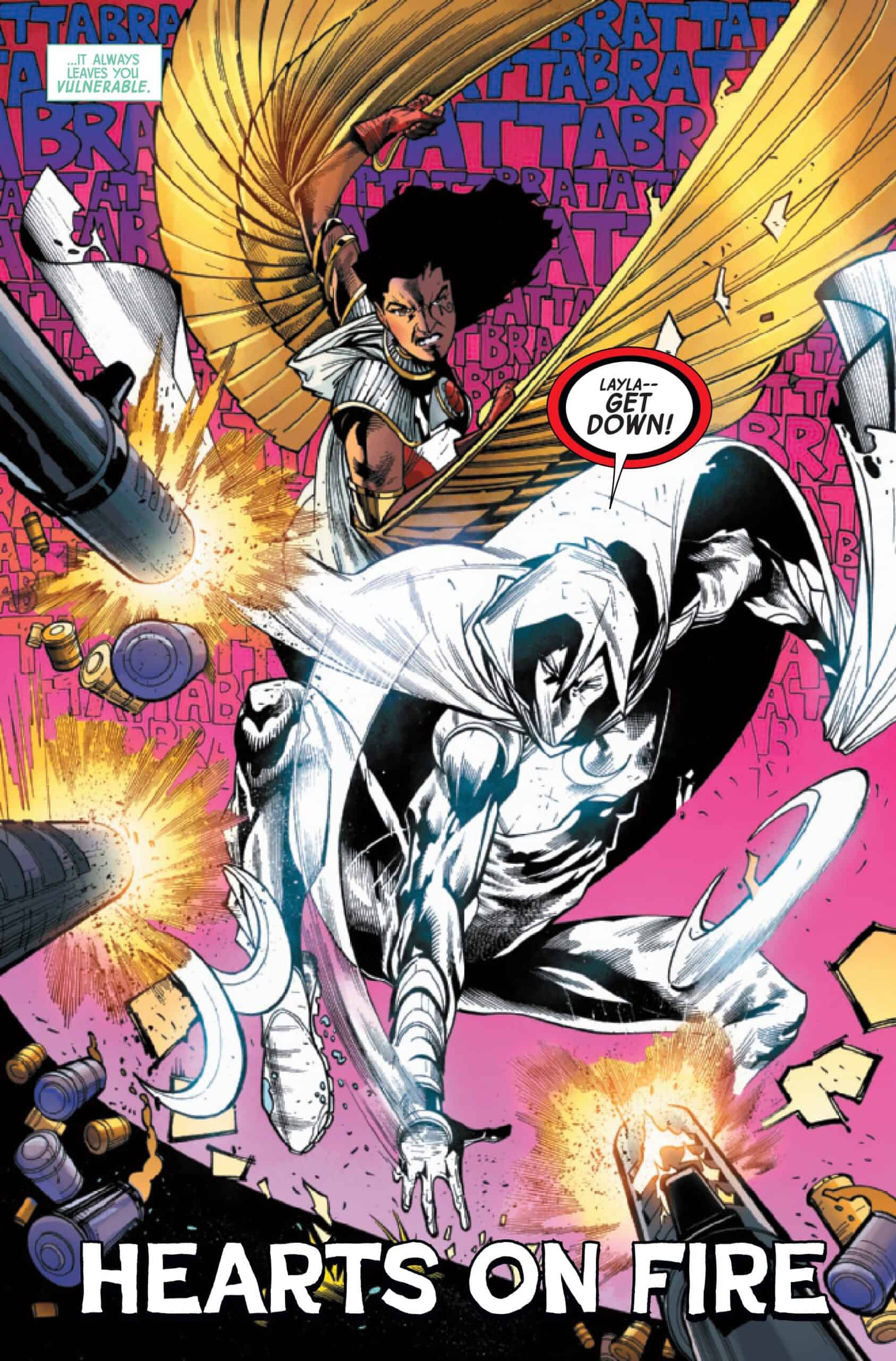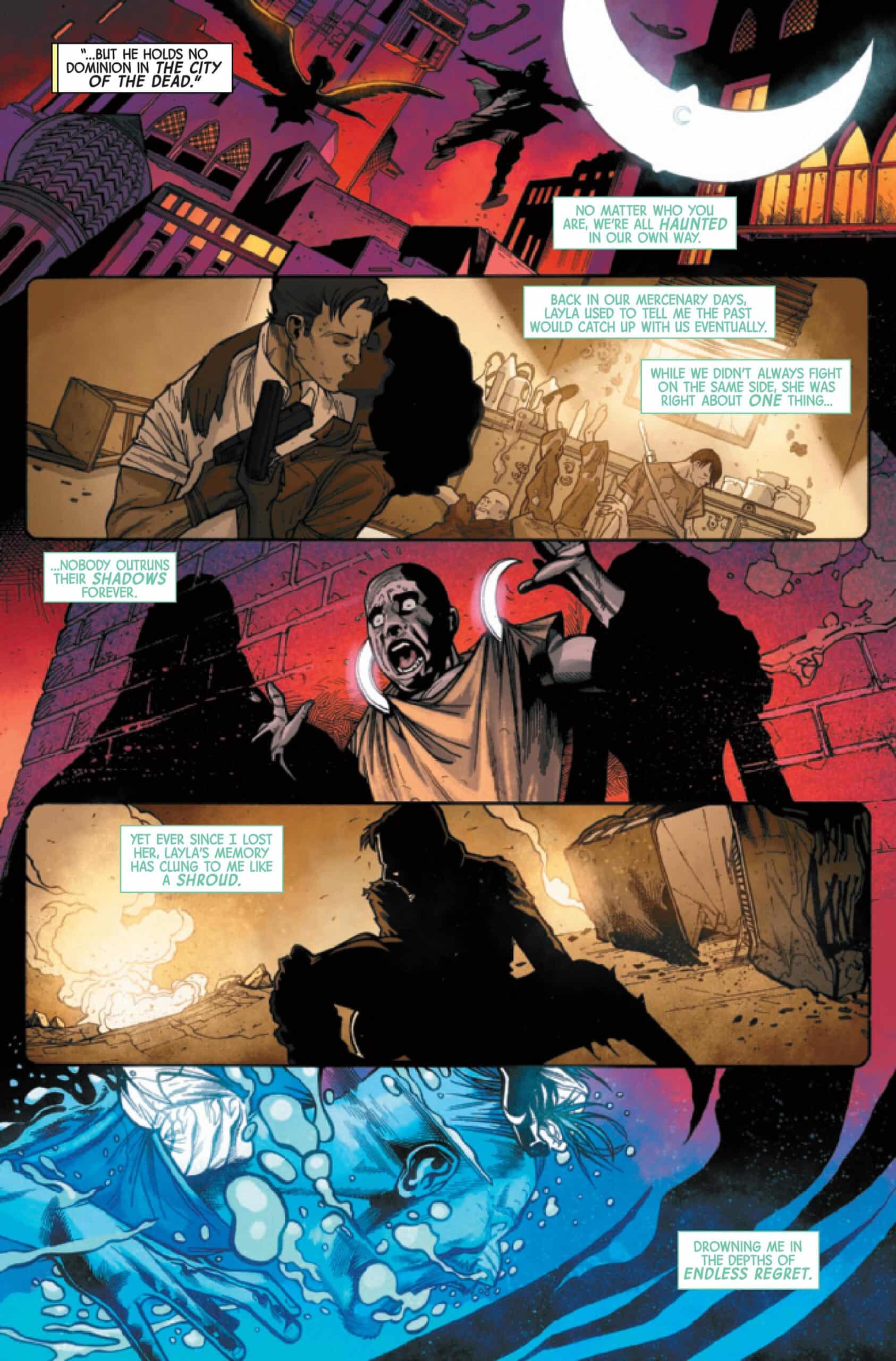Moon Knight: City of the Dead #2

Recap
Tearing through the City of the Dead on his quest to rescue a young runaway, Moon Knight must grapple with his past when he turns to an unlikely source for aid - LAYLA EL-FOULY, A.K.A. the SCARLET SCARAB! But when Marc Spector is faced with a murderers' row of dead super villains whom he helped put in the ground, can even the Fist of Khonshu defy the odds long enough to survive? Plus: Who is the JACKAL KNIGHT?
Review
Warning: Spoilers for Moon Knight #19-25
The use of mythology can infuse an additional flavor to a work, providing a tone and language that supersedes reality. It’s the reason why much of urban fantasy borrows from the fantastical underpinning of mythology, as it takes timeless stories and traditions and morphs them into the present day, creating an interesting dichotomy. Comics have also leaned into these inspirations, echoing the plots of these myths to create a narrative and visual shorthand that allows character and craft to shine.
Moon Knight: City of the Dead #2 – written by David Pepose with pencils by Marcelo Ferreira, inks by Jay Leisten, coloring from Rachelle Rosenberg, and lettering from VC’s Cory Petit – continues the Fist of Khonshu’s journey to Duat, the titular city of the dead. The vigilante’s mission is to locate a young runaway targeted by an Egyptian death cult before they can complete the standard death cult ritual. As Moon Knight descended, he came face to face with Layla El-Faouly, a former, fellow soldier of fortune and ex-lover torn asunder by a mission gone wrong.
Once reunited, and with the revelation of Layla’s new role as the Scarlet Scarab, the two chase down leads to find the missing boy. Meanwhile, the Sons of the Jackal, under the command of the aptly named Jackal Knight, flaunts Moon Knight’s lack of power in Duat. In between fights and threats, Marc learns Layla’s path from her death in Moon Knight #25 to the present and finds himself drawn back into her orbit. The duo is unable to locate the missing boy, instead finding something equally as horrible, as the identity of the Jackal Knight is revealed by the issue’s end.
Pepose’s script is an excellent marriage of past and present, as the writer weaves them together to maximize tragedy and action. The book picks up the plotlines established in the most recent arcs of Moon Knight and mixes in a mythological concept that offers a chance for the internal to become external. The established nature of Duat, in that the city is psychoactive, reacting to a person’s mental state, makes for an excellent tool that plays with the established facets of Moon Knight lore.

The relationship between text and art becomes apparent as Moon Knight’s doubts and wandering mind create physical obstacles. Ferreira’s pencils and layouts reflect the works written in the caption boxes but do so in a way that feels two steps removed from the obvious. Sometimes it will be a literal rushing train of thought that is weaponized on the page, other times Ferreira warps the reality of the background and spaces to masterful effect. It’s a fascinating use of space and mythology to feed story and art and showcase the symbiotic nature of comics.
Like the main Moon Knight title, this miniseries thrives in its depiction of action, as Moon Knight and Scarlet Scarab start to fall into an established rhythm. Ferreira employs a nine-panel grid and then tall, thinner panels to showcase the weaving of reality and remembered, bridging the two through the beats of a fight. It’s an effective way to establish layouts that are clear and concise to read even as they blur facts, fiction, and fears. The depiction of Layla’s powers also gives Ferreira the chance to pivot from the more grounded action of Moon Knight into a bit more of the fantastical, before reminding the reader of Layla’s skills as a former mercenary.

The lettering in the issue also plays up the two styles of action, never being more evident than a killer page towards the first third of the issue. The single-page splash features Moon Knight and Scarlet Scarab leaping in action as machine gun fire rains down on them. The lettering for the “BRATTA” is done in a blocky form that forms the background, showcasing the overwhelming brunt of the attack. Shell casings drop as the two heroes move into action, but the SFX makes clear the action without detracting from the character work.
Even in the moments between the crazy mythological fight scenes, City of the Dead’s art showcases a powerful use of emotion and expression, revealing in the book’s premise to dig deep into character. The descent into the underworld is a recurring theme across mythology and usually relates to a lost or tragically short romance. The art channels this by embracing moments of Marc and Layla’s established history, both in and out of costume.
These beats, like the flashback beats in between the opening chase across the city, divert the energy of the book’s action in the romantically charged moments. A kiss between Marc and Layla in the past and a tender embrace in the present are two instances where these beats come to life. Elsewhere, an echoing set of panels illustrate the continued connection between the two, and details that even as much has changed between them, much of the underlying tension has stayed the same.

The use of past and present come to life in this issue’s coloring from Rosenberg. The present, in the city of the dead, has a vibrant, rich palette of reds and blues that speak to the otherworldly nature of Duat. Back in the past, the color is striped to a sepia tone that evokes a sense of remembrance, shaded by tragedy. These two distinct sets of hues create disparate tones that reflect the physical descent from reality into the mythical and ground the story in the personal tragedy on display.
Final Thoughts
Mythology becomes a strong foundation to reinforce character in Moon Knight: City of the Dead #2, as the Egyptian underworld forces Marc Spector to face his past. The past is proven to be prologue, and Pepose’s writing makes clear that history is inescapable even in a universe filled with gods and aliens. The mythological nature also allows a greater marriage of art and text as the narrative captions creep in and influence the reality of Duat.
Ferreira’s art for the issue picks this up, blending action and expressive character work to highlight the tragedy of Marc and Layla’s past. Rosenberg’s coloring and Petit’s lettering respectively give additional weight to the duality of the story and action. City of the Dead #2 is an example of an additional title building off the main series while developing a unique concept and voice, removing any doubts of redundancy.
Moon Knight: City of the Dead #2: I Will Follow You into the Dark
- Writing - 10/1010/10
- Storyline - 10/1010/10
- Art - 9/109/10
- Color - 10/1010/10
- Cover Art - 10/1010/10





